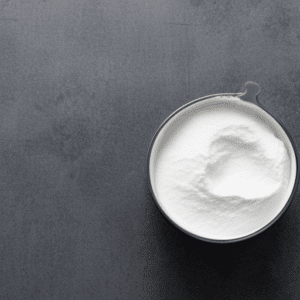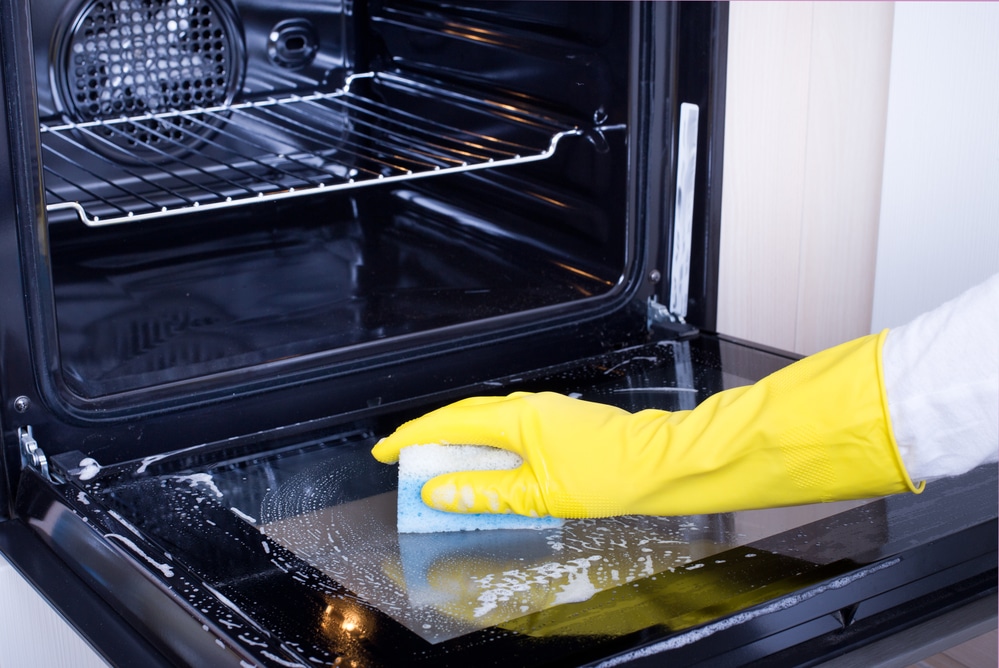There are many appliances and gadgets capable of creating some of the worst messes you have ever seen. However, those that can create the biggest and most expensive messes are items that deal with cooking and storing food.
This is especially so because of the risk of contamination. Ovens are particularly one to keep an eye on. If left dirty, you could be putting your family’s health in danger every time you use them.
Using store-bought oven cleaners has the risk of leaving behind chemical traces that do nothing but make a bad situation worse. Cleaning an oven using natural oven cleaners seems far-fetched, but it is possible.
The best oven cleaner does not come cheap. To help you save money, we have compiled a detailed guide on how to clean your oven without an oven cleaner.
This piece will also touch on a couple of hacks to keep your oven clean.
Steam Your Oven
Before you jump into harsh chemicals for cleaners, you should check if your oven has self-cleaning functionality. While this might sound like an impossible possibility, most modern ovens come with a self-cleaning functionality.
If you don’t have a self-cleaning oven, here’s a similar way to loosen any burnt-on food and lift stubborn stains.
You should do this one evening when you are not planning on using the oven the following morning, as it can be quite a time-intensive ordeal, and you will need to put some work in.
Step 1: Empty Your Oven
Empty your oven and remove all of the oven pans and racks. Put the racks in a large bucket or bath to soak overnight in water with a cleaning agent.
Step 2: Wipe It Clean
Wipe off any excess grease, burnt food, and caked-on food as much as you can. You can scrape it off with a rubber spatula for the food that is really stuck in the oven.
Step 3: Fill a Large Metal Baking Dish With Water
Once you have the water in place, could you put it on the bottom of the oven? Close the oven door, make sure it is secure and then heat the oven to 350F. The water will begin to bubble and steam, which will soften any stubborn food on the inside of your oven.
Step 4: Monitor Water Levels
Keep an eye on the water levels, as you don’t want all of the water to evaporate. After around 30-60 minutes, turn off the oven and spray the interior with a 50:50 water-vinegar solution. Leave this solution for a further 30 minutes and wait for your oven to cool down.
Step 5: Wipe Away Any Residues
Once it is completely cool, you can wipe away any ash residue left behind. It would help if you did this with a damp cloth.
Use a spatula or nylon scouring pad and some elbow grease to scrub off any stuck-on oven grime
You can also apply some homemade oven cleaner to any stubborn spots. We’ll show you how to make it in the next section.
Homemade Oven Cleaners
Have you tried using oven cleaners but don’t like the chemicals they use or always have the best results? Or perhaps you don’t fancy spending much money on your cleaning supplies? If so, you can easily make a natural oven cleaner out of things you can find in your cupboards.
Homemade oven cleaners have been known to be a safe and cheap substitute for store-bought cleaners. The most popular homemade oven cleaner uses baking soda, vinegar, and water. Another popular homemade oven cleaner recipe calls for salt and lemon juice. Lemon juice is a favourite because of its scent.
If you are wondering where to get started, here is a simple homemade oven cleaner recipe.
Ingredients
- Baking Soda
- Warm water
- White vinegar
- Essential oils (optional)
Directions

Add ¾ cup of baking soda to the container you will use, and add ¼ cup of water. Mix the baking soda and water to form a baking soda paste. If you have opted for essential oils, add two to three drops before stirring the mix into a paste. Make sure you have a consistent and spreadable paste.
Separately, add an even amount of vinegar and water to a spray bottle and leave it to the side.
How to Use a Baking Soda Oven Cleaner
Another way to clean your oven is using a baking soda oven cleaner. If you want to use this, follow the steps below:
Step 1: Remove Pans and Racks
Remove the oven pans and racks and leave them to soak in a vinegar and water solution or dishwashing solution.
Step 2: Apply Baking Soda Paste
Apply a thick layer of the baking soda paste all over the oven surface, paying attention to nooks and crannies. You can use a paintbrush or a cooking brush for this. Do not forget to pay particular attention to the oven walls but avoid the metal surfaces of the door and heating elements.
To get into tight spaces, you can use an old toothbrush. Once this is done, let the paste sit overnight or for at least 12 hours.
Step 3: Wipe Your Oven With a Damp Cloth or Paper Towel
Once the 12 hours are up, open the door and wipe down your oven using a damp cloth or paper towel. For stubborn stains, you can use a non-scratch scouring pad to scrub them off.
Repeat this process to wipe clean all the surfaces and remove all the streaks.
Step 4: Spray the Oven’s Interior
Using the spray bottle, spray the oven’s interior with the diluted white vinegar solution to disinfect it and remove any baking soda final remnants.
Cleaning Oven Racks
Oven racks bear the brunt of carrying all the heavy food dishes and baking trays. As such, they, too, need a bit of TLC now and again. Clean oven racks add to your oven looking pristine and your food being safe from contamination.
Oven racks can be the most challenging part of oven cleaning. But if done right, this daunting task can prove to be the easiest.
To properly clean the oven racks, soak the racks in a mixture of very hot water and washing powder overnight.
This will allow the grime and grease to scrub off easily with a damp cloth or a non-abrasive sponge. If you do not fancy powder, you can opt for dryer sheets or dish soap; they work like magic. Remember to scrub the racks to avoid discolouration gently.
Cleaning the Oven Glass
The oven glass comes in handy when you have to check on the progress of your food during cooking. Not having to open the door every so often is key to getting a properly cooked meal, especially when baking.
To clean the glass, you can use a mixture of water and baking soda or baking soda and white vinegar.
Apply the baking soda paste using a brush or cloth to the glass. When the paste is dry, scrape it off using a non-abrasive sponge and then wipe the glass with a moist cloth. You can even steam the door with a steam cleaner to disinfect it after.
How Often Should You Clean Your Oven?
Ideally, the more frequently you clean an oven, the less messy you have to deal with it. In an ideal world, you should clean it at least once a month.
However, you can push your limits and clean it every three to six months, depending on what you use your oven for.
Hacks to Keep Your Oven Spotless
If you are regularly using your oven, then you should regularly clean it. Staying on top of things reduces the amount of time and energy you need to dedicate to cleaning your oven. To help you out, we have come up with several oven-cleaning hacks to keep your oven spotless.
Oven Liners
Liners seem to be the solution to keeping messes contained. This applies to ovens too. If you are constantly baking or cooking in your oven, then spills are inevitable. However, with an oven liner, cleaning up has never been easier.
You can opt for cheap disposable liners or pricy ones that are reusable. Most of the time, reusable liners are dishwasher safe and do not need a little elbow grease to clean. A simple cookie sheet can come in handy, especially when baking. Lining the bottom of the oven with a cookie sheet to catch any spills makes it easy to clean.
Second Roasting Tray
Placing a second roasting tray at the bottom of your oven allows you to catch all the spills and grease from your food. This helps when cleaning out the oven, seeing that you have to pull out the second tray and scrub it down.
Cover Your Food and Do Not Overfill
Before sticking that pot roast into the oven, stick a lid on it. This saves you the trouble of cleaning up spilt grease and sauces from your oven.
Overfilling your casserole dish is probably not a good idea. Because overfilling leads to spilling, which in turn leads to messes. If you have a big meal to cook, look for big dishes to use. This applies to baking trays as well.
Why Should You Keep Your Oven Clean?
Now that you know when and how to clean your oven, let us shift our focus to why it is important to clean your oven.
Whether you use your oven on a daily basis or seldom do, one thing is clear – you have to keep your oven clean. A clean oven guarantees your safety as well as better performance and efficiency.
Here are a few reasons why cleaning your oven is important.
Health
Dirty ovens are the breeding grounds for bacteria and germs. Keeping your oven clean ensures that you are free from salmonella infestations or even E.coli. Your health alone should be enough motivation to keep your oven spick and span.
Fire Hazard
An oven covered in grease and caked with food is a disaster waiting to happen. The top and bottom surfaces of your oven allow for even heat distribution during use. A dirty oven means that the heat will be concentrated in one area, which can lead to fires.
The grease collected at the bottom is prone to smoking. When this happens, you are one step closer to having the fire department break down your door.
Keep Your Oven Squeaky Clean
Oven cleaning is a task that most of us tend to push to the back banner and avoid, but it is necessary to reap its benefits. From health to efficiency, there are lots of reasons why you should deep clean your oven.
These cleaning tips will save you time, money, and lots of elbow grease—cleaning cycles and processes that do not use store-bought chemical cleaners safe both safe and healthier. If you are a strong believer in greener earth, then this is the way to go. You can even opt for simple and natural oven cleaners like lemon juice.

